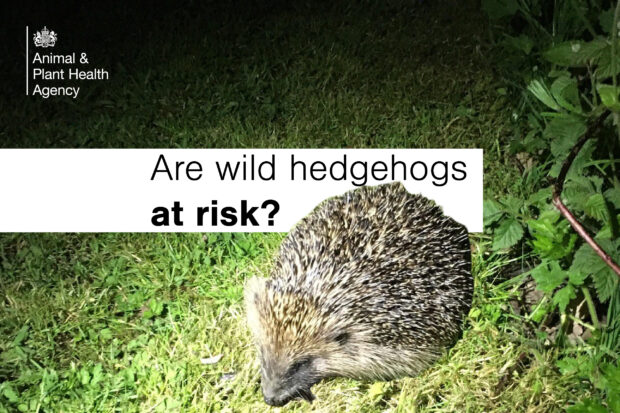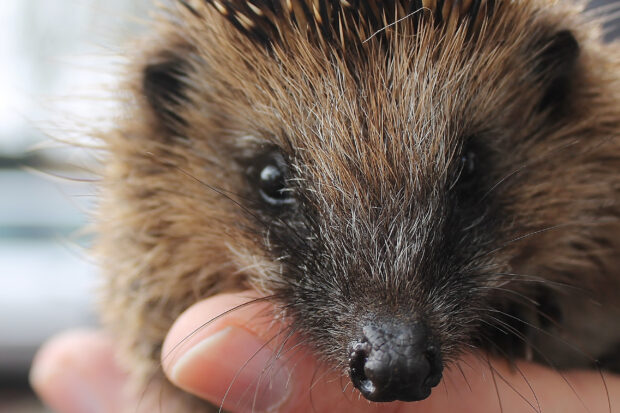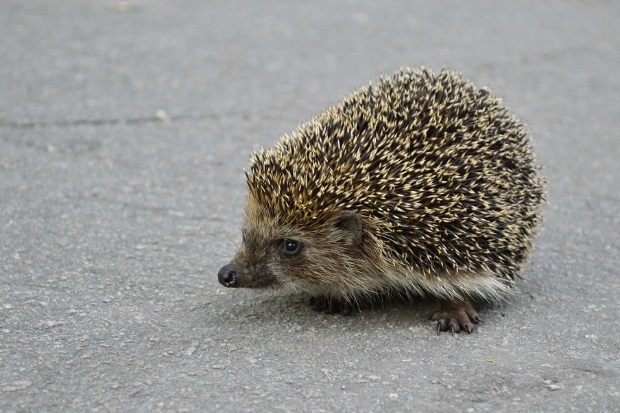
Are wild hedgehogs at risk from a new virus?
European hedgehogs, once a common sight in our hedgerows, woodland and gardens, are now in serious decline in the United Kingdom (UK). British hedgehogs have declined by up to 75% in rural areas since 2000 and are now recognised as a species of conservation concern (classified as ‘near threatened’ on the International Union for Conservation of Nature (IUCN) red list in Europe). While habitat loss and traffic accidents are considered to be two of the most important reasons driving this decline, there is no doubt that a combination of many factors are involved. It is important to try to understand all threats to hedgehog survival if we are to protect the species now and in the future.
A novel hedgehog virus was discovered in 2019, when an outbreak of neurological disease began in wild hedgehogs admitted to a wildlife hospital and rehabilitation centre in England. The outbreak lasted for four months and approximately half of the hedgehogs admitted died or were put to sleep due to severe neurological disease. Both young and adult hedgehogs were affected. In many instances, the animals lost their appetite a few days after admission, before progressing to more serious signs or death, although others took up to six weeks before showing signs of neurological disease.
The attending veterinarian at the wildlife hospital performed gross postmortem examinations of three newly dead hedgehogs, but no major macroscopic changes were identified. Specialist veterinary examination by a pathologist at the International Zoo Veterinary Group (IZVG) concluded similar microscopic lesions in the fixed brain tissues of the three hedgehogs, consistent with a common cause. However, no specific cause could be established through these examinations.
Scientists at APHA were approached by the IZVG pathologist to help with resolving the cause of this outbreak. Utilising cutting-edge technologies such as Next Generation Sequencing (NGS), APHA scientists have discovered a new arterivirus in these three hedgehogs, named hedgehog arterivirus (HhAV). No other viral pathogens could be identified in brain tissues of the animals.
Arteriviruses are a type of virus which can infect a wide range of mammals but commonly found in mice, horses, pigs and monkeys. They are known to be host specific, infecting a single animal species (so each arterivirus infects only one host species – in this case, the hedgehog), and are not known to be transmitted by vectors such as fleas and mites. Although most arteriviruses appear to cause subclinical infections (without disease signs) some can cause acute or persistent infections with signs varying from low level and chronic to severe and life threatening.
In hedgehogs, it appears that arterivirus can be present without any signs of disease (subclinical). In clinical cases, early indicators of the disease are wobbliness (which can also occur when hedgehogs are dehydrated), breathing difficulties and lethargy. Nervous signs generally occur within three days of appetite loss and can include tremors (shaking), twitching, increased sensitivity to touch and other stimuli, disorientation, and paddling legs after falling to one side. Later signs can include seizures. Hedgehogs showing these signs often will not survive.
As the disease appeared to develop after admission to the hospital, all cases were considered to have been hospital-acquired at that time. Strict hygiene, biosecurity, and reduced juvenile admissions eventually brought a halt to the outbreak which resulted in more than 200 deaths. Postmortem investigations showed these hedgehogs to be suffering from encephalitis (swelling of the brain).
In a collaborative study, APHA, IZVG, and Garden Wildlife Health investigated whether this virus was the cause of the encephalitis using microscopic and hybridisation techniques. We found that the virus was present in areas of brain with encephalitis, suggesting a link between the virus and the brain inflammation. The virus was also found in other organs such as lung, heart, liver, kidney, testes, and blood vessels, indicating a systemic (across all body systems) infection.
Each year, thousands of hedgehogs are brought to wildlife care centres in Great Britain (GB) for treatment and rehabilitation. It is, therefore, important to further investigate the threat of this virus to both wild hedgehogs and those in the care of rescue and rehabilitation centres. We are continuing to research both the occurrence of the virus in wild and rehabilitating hedgehogs and virus genome characteristics. This research will help us to identify viruses’ diversity and the relationships between the viruses found in different animals and locations.

Thanks to our collaborators from hedgehog rescue centres, we have so far received the bodies of 143 deceased hedgehogs for HhAV research, 104 of the hedgehogs (73%) tested positive for the HhAV indicating that a large proportion of wild hedgehogs brought into rescue centres harbour this virus. Many of the hedgehogs submitted presented to the rescue centres with disease signs suggestive of HhAV infection at the time of admission, others developed disease signs during their stay or died of unknown illness. So far, we have found HhAV in hedgehogs from rescue centres in nine counties in England.
We have also received 27 faecal samples collected from live wild hedgehogs in Yorkshire, thanks to colleagues from APHA National Wildlife Centre. Four of the faeces (14.8%) tested low positive for the HhAV. This finding indicates that there are HhAV carriers amongst the wild population of hedgehogs. We have also detected HhAV in wild free-living hedgehogs with encephalitis, euthanised due to severe neurological signs. Studies are underway to confirm a link between the virus and the encephalitis in these hedgehogs, but this finding supports our suspicion that the disease occurs in wild hedgehogs that have not been admitted to rescue and rehabilitation centres.
Since the initial outbreak, we have sequenced the HhAV genome from eight hedgehogs with signs of encephalitis. The viruses’ sequence identity ranges from 76.2% to 100% showing quite a range in genome sequence between individual viruses. These sequence data allowed us to develop a PCR based diagnostic method for disease investigation and our research studies. The data also shows differences between viruses from each geographical region which is in line with hedgehogs' natural social behaviour. Hedgehogs are solitary nocturnal animals that stay in the same location during their lifetime, spending most of their time alone except during the mating season.
The results of our work so far have meant that we were able, in collaboration with rescue centres, to compile a document of safety measures to reduce the spread of the virus within the rescue and rehabilitation environment. This should help to mitigate the risk of this virus and other significant and devastating infectious disease outbreaks in future.
As with many viral diseases of wildlife, no clinical treatment is currently available for this disease in hedgehogs, and supportive care is often all that can be offered. Our research is aimed to further increase our understanding of this virus, its distribution in the GB hedgehog population and predisposing factors that contribute to neurological disease. We hope to eventually be able to develop robust tests to identify carrier hedgehogs and for diagnosis of disease caused by the virus. Currently, we can only do this for hedgehogs after they have died, but a non-invasive test that could be done on a live hedgehog would be our ultimate aim. This would enable rescue centres to quarantine the most ‘at risk’ individuals on admission to the centre.

The ongoing loss of hedgehog natural habitat in rural areas is progressively causing hedgehogs to be displaced into parks and gardens of homes, increasing their direct contact and the potential for transmission of pathogens. This loss of habitat subjects hedgehogs to frequent road accidents, injuries and hospitalisation, increasing the incidence of close exposure to other hedgehogs or other animal species in care facilities. It is not unreasonable to predict therefore, that outbreaks of infectious diseases of hedgehogs, such as those caused by HhAV, and the evolution and potential transmission of these viruses to other animal species will increase over time. Therefore, research and disease investigation studies such as this are essential to monitor hedgehog viral pathogens and their impact on this vulnerable population.
Further reading
Arteriviruses in Hedgehogs - Garden Wildlife Health
References
Dastjerdi A, Inglese N, Partridge T, Karuna S, Everest DJ, Frossard JP, Dagleish MP, Stidworthy MF. Novel Arterivirus Associated with Outbreak of Fatal Encephalitis in European Hedgehogs, England, 2019. Emerg Infect Dis. 2021 Feb;27(2):578-581. doi: 10.3201/eid2702.201962.
Dastjerdi A, Davies H, Inglese N, Holland S, Samborskiy DV, Gorbalenya AE. Intraspecific variation of the hedgehog arteriviruses, which may constitute a new genus in the subfamily Heroarterivirinae of the family Arteriviridae. Arch Virol. 2025 Feb 8;170(3):49. doi: 10.1007/s00705-025-06231-7.
Lean FZX, Stidworthy MF, Dastjerdi A, Partridge T, Smith S, Gough J, Núñez A, Lawson B, Seilern-Macpherson K. Colocalization of hedgehog arterivirus 1 (HhAV-1) and histologic lesions in the European hedgehog (Erinaceus europaeus) with neurological disease. Vet Pathol. 2024 Dec 12:3009858241300553. doi: 10.1177/03009858241300553.

9 comments
Comment by Alison Noble posted on
Very interesting and vital information.
Comment by Monica posted on
A month ago a neighbour found a dead hedgehog in his garden.
Sunday 11th May saw a hedgehog in my garden at 8pm. Fed it with mealworms and gave water. Bought hedgehog food and continued to do this until 21st May when it was out during the day. Offered food and water and found him later on lawn on its side, again food and water and he seemed to recover. At 8pm a neighbour saw a dead hedgehog outside our front wall. I haven’t seen my one since, so must have been my hedgehog.
Wednesday 14th May I was walking up the next residential road and where it joins a busy B road I found a dead hedgehog on the pavement that had been injured so may have been a roadkill.
I am very fond of hedgehogs as they often visit our garden, so it is very sad that three have died so recently.
Comment by Daniel Gallo posted on
It's lovely that you care about the hedgehogs visiting your garden, but it's important to know that mealworms aren't safe for them - they can cause serious health issues like metabolic bone disease.
The best food to offer healthy visiting hedgehogs is meaty cat biscuits - look for ones with meat as the first listed ingredient.
Also, a hedgehog seen out in the daytime is usually unwell and needs help. In such cases, it's best to contact a local wildlife rescue that specialises in hedgehogs rather than a vet, as they have the right experience to care for them.
Thank you for looking out for them.
Comment by Hedgehog Bottom posted on
Please do not feed hedgehogs mealworms. Those plus sunflower hearts and peanuts are high in phosphorus and very low in calcium. This can cause Metabolic bone disease which has no cure. We have had three youngsters in so far this year with major calcium depletion causing deformed bone ends and fractures, all were unable to walk and all had to be euthanised. Hedgehog specific food or cat/kitten biscuits or small dog biscuits and plenty of water is all that is required to top up their natural diet
Comment by Pippa posted on
Feeding mealworms to hedgehogs can cause metabolic bone disease, which cannot be treated and is fatal.
Comment by William Fenn posted on
There are very few Wild hedgehogs as badgers have killed them all! Now we have buzzards and kites everywhere and everything else is being destroyed! My farm had an abundance of hedgehogs, rabbits, fieldmice, game and even the odd harvest mouse was spotted but now even the fox's have all but disappeared! And now I read the bunny huggers (if they can find one) want to release golden eagles! What is this perverse obsession with predators?
Will Fenn, kingscliffe.
Comment by Margaret Handley posted on
In our very rural village, I know of two hedgehogs that were killed by mink.
The mink also attack and sometimes kill cats.
This year so far, I have only seen one hedgehog coming for food in my garden. This is unusual. Friends in the village have also noticed the recent decline in hedgehogs.
Comment by Sue. posted on
Please don't feed mealworm. They cause awful problems to hedgehogs. Do a little research for explanations.
Many of us who feed hedgehogs use kitten biscuits, looking for chicken to be first in contents list. Pet foods are regulated hedgehog food isn't so could be anything.
Comment by Peter Drake posted on
The increasing growth of viruses in the natural habitat is a cause of great concern. Part of the issue is the closeness of humankind to the animal kingdom which facilitates movement of a virus from one species to another.
Peter Drake classroom science teacher Hexham Northumberland UK